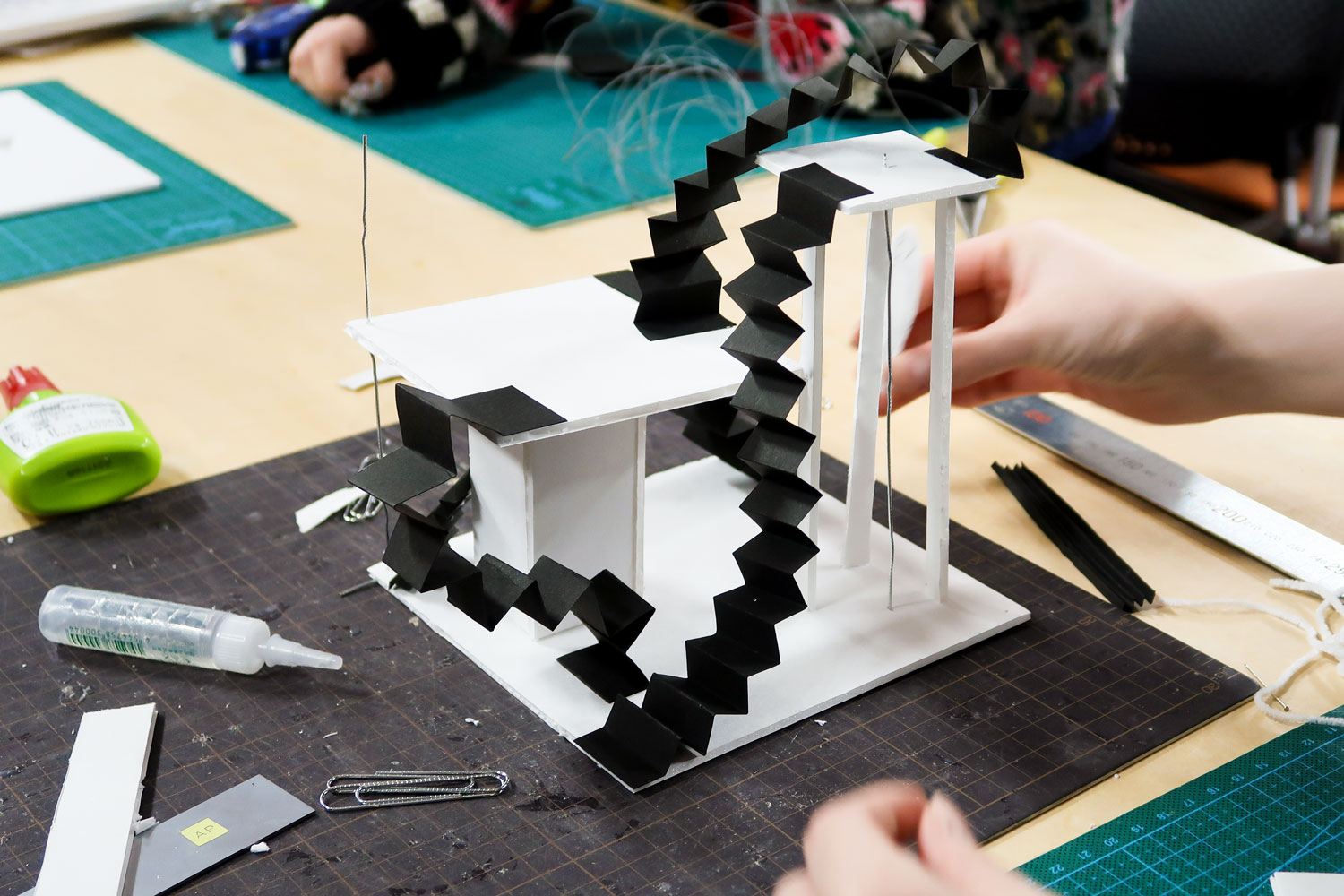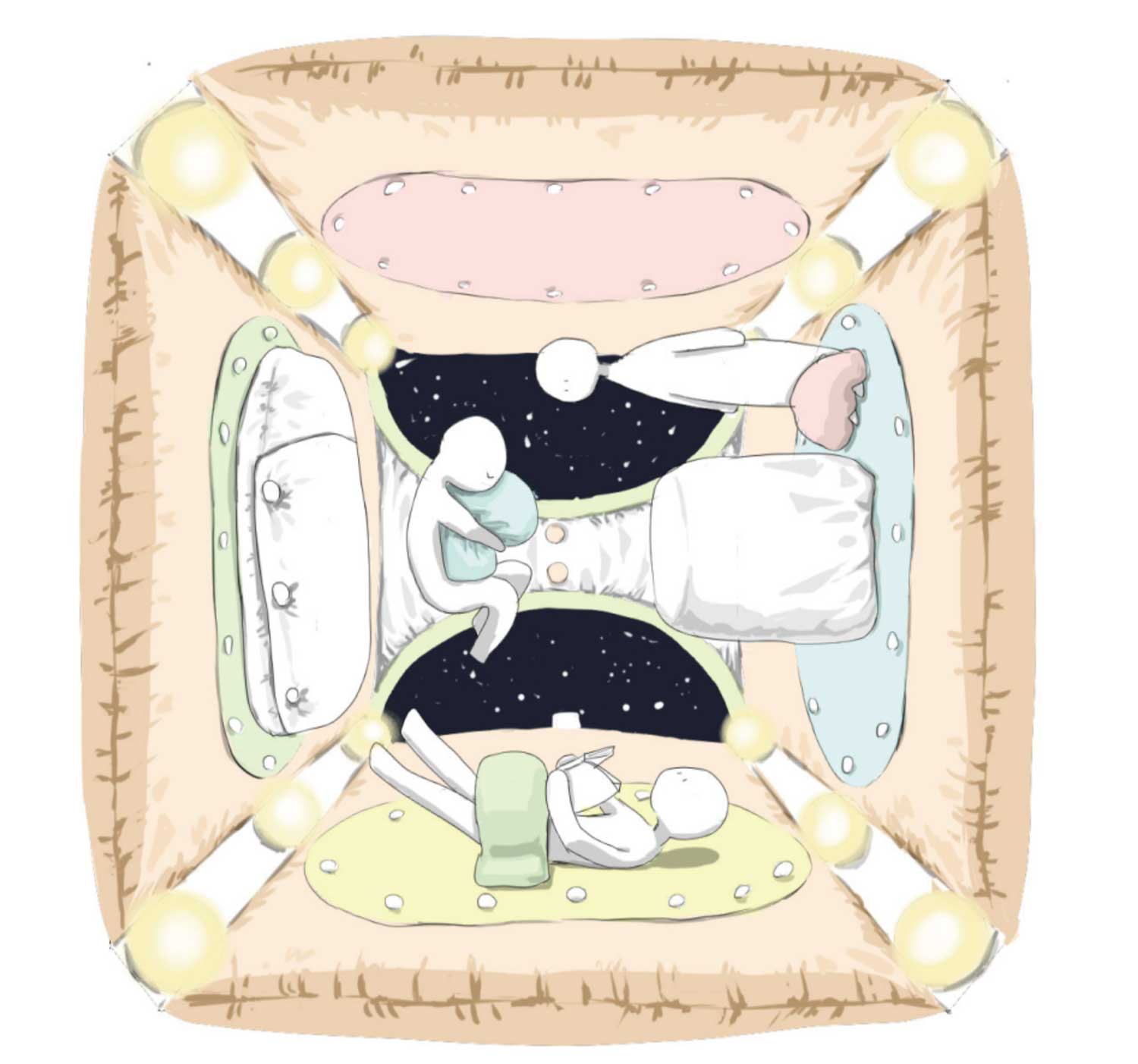Field of Art and Design for Spatial Experience
Joshibi University of Art and Design
Curriculum Overview
In the Field of Art and Design for Spatial Experience, students not only acquire the skills and knowledge to create objects and structures, such as in architecture, interior design, and urban planning, but also focus on the “human senses.” Through various practical and hands-on exercises, they learn to create “spatial experiences” from unique perspectives. Here is the learning flow and key classes from the first to the fourth year.
Outline
Basic Knowledge and Concepts
![]()
1st Year
- Spatial Creation: Foundation I (Ergonomics)
- Spatial Creation: Foundation II (Drawing)
- Spatial Creation: Foundation III (Modeling)
- Spatial Creation: Foundation IV (Virtual Modeling)
- Primitive Space I
- Temporary Space I
- Immersive Space I
Mastering the Basics of Spatial Expression and Thought
In the first year, students learn foundational techniques essential for spatial expression, including ergonomics, technical drawing, scale modeling, and 3D graphics. Additionally, as a new framework for understanding space, students will gain hands-on experience with the three core concepts: “Primitive Space,” “Temporary Space,” and “Immersive Space.”
First Year Classes
Conceptual Exercises
![]()
2nd Year
- Primitive Space II
- Temporary Space II
- Immersive Space II
- Primitive Space III
- Temporary Space III
- Immersive Space III
- Human Space I
Integrating Knowledge and Skills to Explore Expertise
Building on the foundations learned in the first year, students will delve deeper through exercises and projects, advancing their creativity and understanding. In the first semester, they will explore a range of spatial experiences, from primitive spaces essential for survival to community spaces, as well as immersive environments such as theater, games, film, and VR. In the second semester, students will integrate these experiences to explore and define their areas of expertise.
Second Year Classes
Advanced Exercises
![]()
3rd Year
- Human Space II
- Human Space III
- Project Production (Workshop)
- Third-Year Seminars
Deepening Unique Creativity and Expertise through Practical Projects
Our students in the third year embark on a unique learning journey, engaging in collaborative projects both within and outside the university. This journey is designed to help them understand how their creativity intertwines with society. They delve into various spatial theories, gaining a deeper perspective on spatial concepts. In the second semester, they join seminars focused on art, design, or theory, honing their expertise in “space” in preparation for their graduation projects.
Deepening and Expression
![]()
4th Year
- Fourth Year Seminars
- Project Production II (Workshop)
- Graduation Projects
Deepening Expertise and Communicating to Society
In the fourth year, students further pursue their expertise through seminars and project-based learning. The culmination of their four years of study is the graduation project, where students present their work to society as innovative creators and producers. Through various approaches such as installation art, stage design, film art, community design, entertainment design, and VR, they convey their creativity and contributions to enrich society.
Subjects
Practical Subjects (Excerpts)
*The subjects listed here are examples. Various other practical subjects are also available.

Primitive Space I - III (Workshops)
In these subjects, we explore the beginnings of space, specifically when a person recognizes a particular place as a unique environment. We investigate what happens within that person and their environment through various practical assignments. Examples of themes for these assignments include “open fires,” “hideouts,” and “being lost,” all of which are often cited as fundamental spatial experiences.

Temporary Space I - III (Workshops)
In these subjects, we explore how the same space can change its face momentarily. We consider differences in time of day, events occurring within the space, and the people present. Themes for assignments include elements that transform space temporarily and momentarily, such as “light,” “arrangement,” and “events.”

Immersive Space I - III (Workshops)
In these subjects, we explore the possibilities of creating space experiences that captivate and fully engage people. Through various practical assignments, we investigate what makes an immersive space. Assignment themes include areas of expression that create extraordinary experiences, such as “theater,” “VR,” and “amusement parks.”
Sample Works:
OKANO Mana, Field of Art and Design for Spatial Experience

Human Space I - III (Workshops)
After mastering the three concepts of space—“Primitive,” “Temporary,” and “Immersive”—students will delve into the practical application of these ideas in real-life situations to craft more enriching experiences. Through hands-on assignments, we dissect crucial aspects of human life, such as “rest,” “activity,” and “encounters,” as assignment themes. Students are actively encouraged to ponder these themes while nurturing their interests.
Sample Works:
NISHIDA Hidemi “The Curtain of the Tea Field“ (Photo: SUZUKI Ryuichiro)

Project Production (Workshop)
Building on the knowledge and methods learned so far, students will identify real-world scenarios and challenges in society and initiate projects to enhance them. This class involves collaboration with other fields within the Department of Cross-Disciplinary Art and Design, where students develop and present concrete proposals and solutions to the public.
Sample Works:
Department of Cross-Disciplinary Art and Design “Nukuri Art Corridor Project”

Third-Year Seminars, Fourth-Year Seminars, and Graduation Projects
From the second semester of the third year, classes are conducted in a seminar format. Students will draw on the various approaches they have learned, as well as their interests and experiences, to identify a theme they wish to explore in depth. In the second semester of the fourth year, students will refine their chosen research themes. As researchers or creators, they will compile their ideas and research findings into works, proposals, or theses, which they will present.
Sample Works:
Department of Cross-Disciplinary Art and Design “Nukuri Art Corridor Project”
Academic Subjects (Excerpts)
Art and Society
This subject explores how art has reflected society and how society has perceived and responded to these reflections. It examines the attitudes of artists when confronting society and the reactions of society to their work. The subject considers these issues from two perspectives: the social-sculptural perspective of artists and the policy-making perspective of government administration.
Nonlinear Narrative
The narratives (events, challenges, information) people experience individually are scattered and progress nonlinearly worldwide. One of the roles of a creator is to encounter these unknown narratives occurring in unknown places and figure out how to connect them.
Introduction to Art and Design for Spatial Expression
History of Spatial Arts
Introduction to Perception and Senses
Materials and Construction
History of Lifestyles
Spatial Concepts
Sample Works
Throughout the four years, students in the Field of Spatial Expression engage in various practical assignments. These range from individual projects to group work and collaborative productions with other fields. Through these diverse creative processes, students refine their creative skills.
*The featured works are reference projects by students from other majors.

Group 4 Students’ work from Design for Healing A 2023

Group 7 Students’ work from Design for Healing A 2023

Group 5 Students’ work from Design for Healing A 2023

OGAWA Nao, Field of Media Art and Design, Department of Cross-Disciplinary Art and Design

MATSUMOTO Raimu, Design Course, Joshibi Collage of Art and Design
Inquiries
Please visit the official website of
Joshibi University of Art and Design
for admission details and to request materials.
